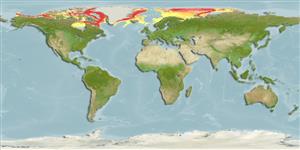Environment: milieu / climate zone / depth range / distribution range
Écologie
marin bathydémersal; profondeur 50 - 1400 m (Ref. 117245). Deep-water; 80°N - 58°N, 161°W - 104°E (Ref. 117245)
Northeast Atlantic: eastern central Greenland southeast to just north of the Faroes, Jan Mayen Island, around Spitsbergen and northern parts of Barents Sea. Arctic: Franklin Bay, North Western Territory and Alaska (Ref. 11976); also the Kara and Beaufort seas.
Taille / Poids / Âge
Maturity: Lm ? range ? - ? cm
Max length : 51.7 cm TL mâle / non sexé; (Ref. 11976)
Description synthétique
Clés d'identification | Morphologie | Morphométrie
Vertèbres: 96. Pelvic fins small (Ref. 4695). Uniformly or mostly dark, with 5-8 short, light cross-bands; band across nape, if present, straight, not curved forward; peritoneum dark, with dense brownish-black dots (Ref. 4695).
Found on muddy bottoms (Ref. 4695). Benthic (Ref. 58426). Feeds mainly on epibenthic animals. With increase in size, shrimps and euphausiids are ingested in greater quantities but unlike L. reticulatus, its ingestion of smaller prey items does not decrease. Changes in feeding habit with size are relatively small (Ref. 13532).
Life cycle and mating behavior
Maturities | Reproduction | Spawnings | Egg(s) | Fecundities | Larves
McAllister, D.E., M.E. Anderson and J.G. Hunter, 1981. Deep-water eelpouts, Zoarcidae, from Arctic Canada and Alaska. Can. J. Fish. Aquat. Sci. 38(7):821-839. (Ref. 11976)
Statut dans la liste rouge de l'IUCN (Ref. 130435)
Menace pour l'homme
Harmless
Utilisations par l'homme
Outils
Articles particuliers
Télécharger en XML
Sources Internet
Estimates based on models
Preferred temperature (Ref.
123201): -0.7 - 2.6, mean 0.4 °C (based on 489 cells).
Phylogenetic diversity index (Ref.
82804): PD
50 = 0.5000 [Uniqueness, from 0.5 = low to 2.0 = high].
Bayesian length-weight: a=0.00275 (0.00171 - 0.00444), b=3.20 (3.06 - 3.34), in cm total length, based on LWR estimates for this species & Genus-body shape (Ref.
93245).
Niveau trophique (Ref.
69278): 3.4 ±0.44 se; based on food items.
Résilience (Ref.
120179): Très faible, temps minimum de doublement de population supérieur à 14 ans (Preliminary K or Fecundity.).
Fishing Vulnerability (Ref.
59153): Moderate vulnerability (41 of 100).
